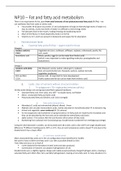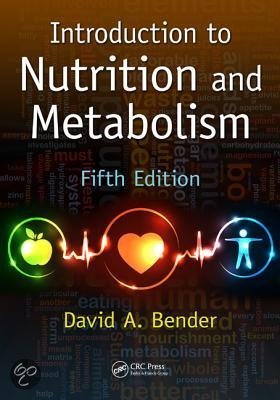NP10 – Fat and fatty acid metabolism
There is no requirement for fat, apart from small amounts of two polyunsaturated fatty acids (PUFAs) – we
can synthesize fats from carbs or amino acids
• Fat provides 39 kJ/ gram (vs protein 17 and carbohydrate 16 kJ/g) at relatively high levels of intake it is
easy to overeat, at very low levels of intake it is difficult to meet energy needs
• Fat lubricates food in the mouth, making chewing and swallowing easier
• Much of the flavour in foods (especially meat) is in the fat
• Vitamins A, D, E, and K are present in dietary fat and require fat for absorption
Nomenclature lipids
Essential fatty acids (PUFAs) – urgent need for those
Omega 6
Linoleic acid (LA) Vegetable oils (corn, sunflower, safflower, soybean, cottonseed), poultry fat,
C18:2 nuts, seeds
Arachidonic acid Meats, poultry, eggs (or can be made from linoleic acid)
(which is very important to make signalling molecules: prostaglandins and
leukotrienes)
Omega 3
Linolenic acid (ALA) Oils (flaxseed, canola, walnut, wheat germ, soybean)
C18:3 Nuts and seeds (butternuts, flaxseeds, walnuts, soybean kernels),
vegetables (soybeans)
EPA and DHA Human milk à important for brain development
C22:6 Pacific oysters and fish (or can be made from linolenic acid)
Lipids: class of nutrients without structural relation
1. Tri-acylglycerol = TG = triglycerides (what we call fats)
3x fatty acids (always one acid group) esterified to glycerol backbone
§ Saturated fatty acid: more solid, very stiff – no double bond, not flexible
§ Mono- unsaturated fatty acid (oleic acid)
§ Polyunsaturated fatty acid (linoleic acid: C18:2 omega6)
a) Fatty acids characteristics
• Monobasic (1 acid) and unbranched (alkane/ alkene) - linear
• Aliphatic (not circular) monocarbonic acids, mainly saturated or mono/bisaturated à no benzene ring
• Animal and vegetable: even numbered (4- 26 carbons)
• Vs microorganisms odd numbered: C3 (proprionate) or C5 fatty acids are made by the microbiota and
they can be absorbed by the host and can be extended to extend fatty acid chains
• alpha-carbon = first carbon after the acid function (first carbon of fatty acid)
• Numbering from carbonyl end: functional group. Double bonds numbered from methylgroup (omega)
Compare C18:0 (stearate in candles, can be burned) and C18:1 (oleic acid is olive oil)à one single double bond
difference à different melting points: 69°C vs 13°C, thus at room temperature solid vs liquid à only due to the
double bond it has a major effect
b) cis- and trans- double bonds
Most unsaturated fatty acids are in the cis-configuration (more beneficial for health)
We want to have as little trans-fatty acid in our diet as possible (linked to CVD)
Trans fatty acid occur as a result of
§ rumen bacterial fermentation (in beef, lamb and dairy products)
§ isomerization in factories via catalytic hydrogenation of oils
Double bonds carry a slightly negative charge and readily accept positively charged hydrogen atoms, creating a
saturated fatty acid. Most often, fat is partially hydrogenated, creating a trans-fatty acid. In many situations it is





